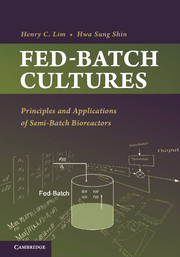Book contents
- Frontmatter
- Contents
- Preface
- Acknowledgments
- 1 Introduction to Fed-Batch Cultures
- 2 Idealized Reactors and Fed-Batch Reactors
- 3 Maximization of Reaction Rates and Fed-Batch Operation
- 4 Phenomena That Favor Fed-Batch Operations
- 5 Classification and Characteristics of Fed-Batch Cultures
- 6 Models Based on Mass Balance Equations
- 7 Non–Equation-Based Models
- 8 Specific Rate Determination
- 9 Optimization by Pontryagin's Maximum Principle
- 10 Computational Techniques
- 11 Optimization of Single and Multiple Reactions
- 12 Optimization for Cell Mass Production
- 13 Optimization for Metabolite Production
- 14 Simple Adaptive Optimization
- 15 Measurements, Estimation, and Control
- 16 Feasibility Assessment and Implementable Feed Rates
- Index
- References
2 - Idealized Reactors and Fed-Batch Reactors
Published online by Cambridge University Press: 05 April 2013
- Frontmatter
- Contents
- Preface
- Acknowledgments
- 1 Introduction to Fed-Batch Cultures
- 2 Idealized Reactors and Fed-Batch Reactors
- 3 Maximization of Reaction Rates and Fed-Batch Operation
- 4 Phenomena That Favor Fed-Batch Operations
- 5 Classification and Characteristics of Fed-Batch Cultures
- 6 Models Based on Mass Balance Equations
- 7 Non–Equation-Based Models
- 8 Specific Rate Determination
- 9 Optimization by Pontryagin's Maximum Principle
- 10 Computational Techniques
- 11 Optimization of Single and Multiple Reactions
- 12 Optimization for Cell Mass Production
- 13 Optimization for Metabolite Production
- 14 Simple Adaptive Optimization
- 15 Measurements, Estimation, and Control
- 16 Feasibility Assessment and Implementable Feed Rates
- Index
- References
Summary
Prior to presenting the principles of fed-batch operations, it is instructive to review quickly various forms of idealized reactors: batch, continuous, and semi-batch reactors. This will help in understanding the simplest form of fed-batch operation as equivalent to a continuous-stirred tank reactor (CSTR) followed by a batch reactor (BR). It becomes simple and easy to understand the operation of a fed-batch bioreactor as mimicking a dynamic CSTR followed by a BR to maximize the reaction rate or product yield. In other words, for a single reaction, the sufficient condition for superior performance of fed-batch operation is that the reaction rate and/or product yield show a maximum or decrease with the substrate concentration.
Basically, a fed-batch operation is preferred when the main or a side reaction rate exhibits a maximum or if the side reaction is more sensitive than the main reaction to reactant concentrations. Fed-batch operations can take advantage of the maximum rate or the sensitivity of side reactions (yield) by manipulating the substrate (reactant) concentration in the reactor.
- Type
- Chapter
- Information
- Fed-Batch CulturesPrinciples and Applications of Semi-Batch Bioreactors, pp. 19 - 32Publisher: Cambridge University PressPrint publication year: 2013
References
- 1
- Cited by



